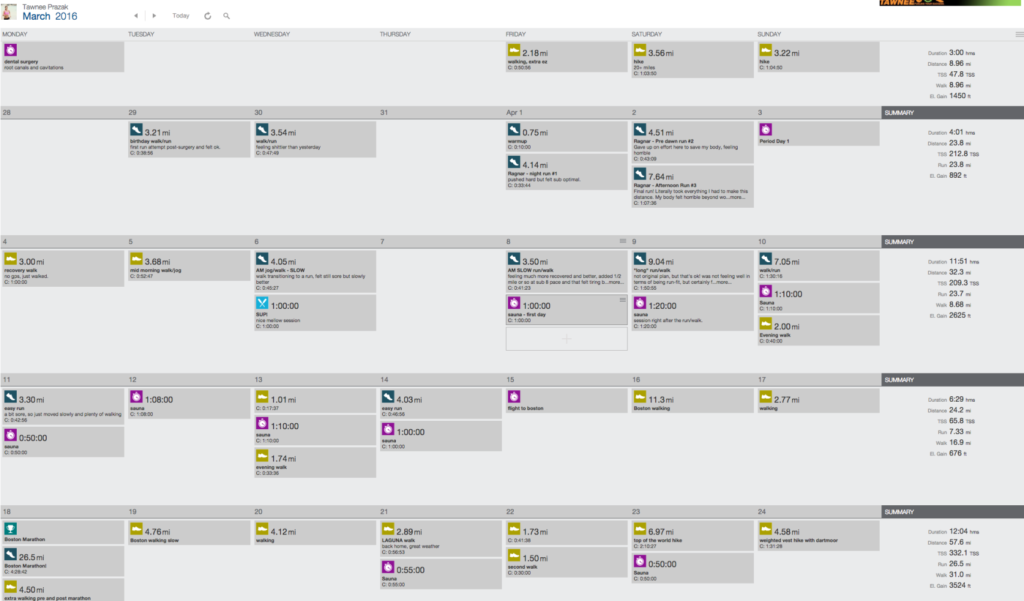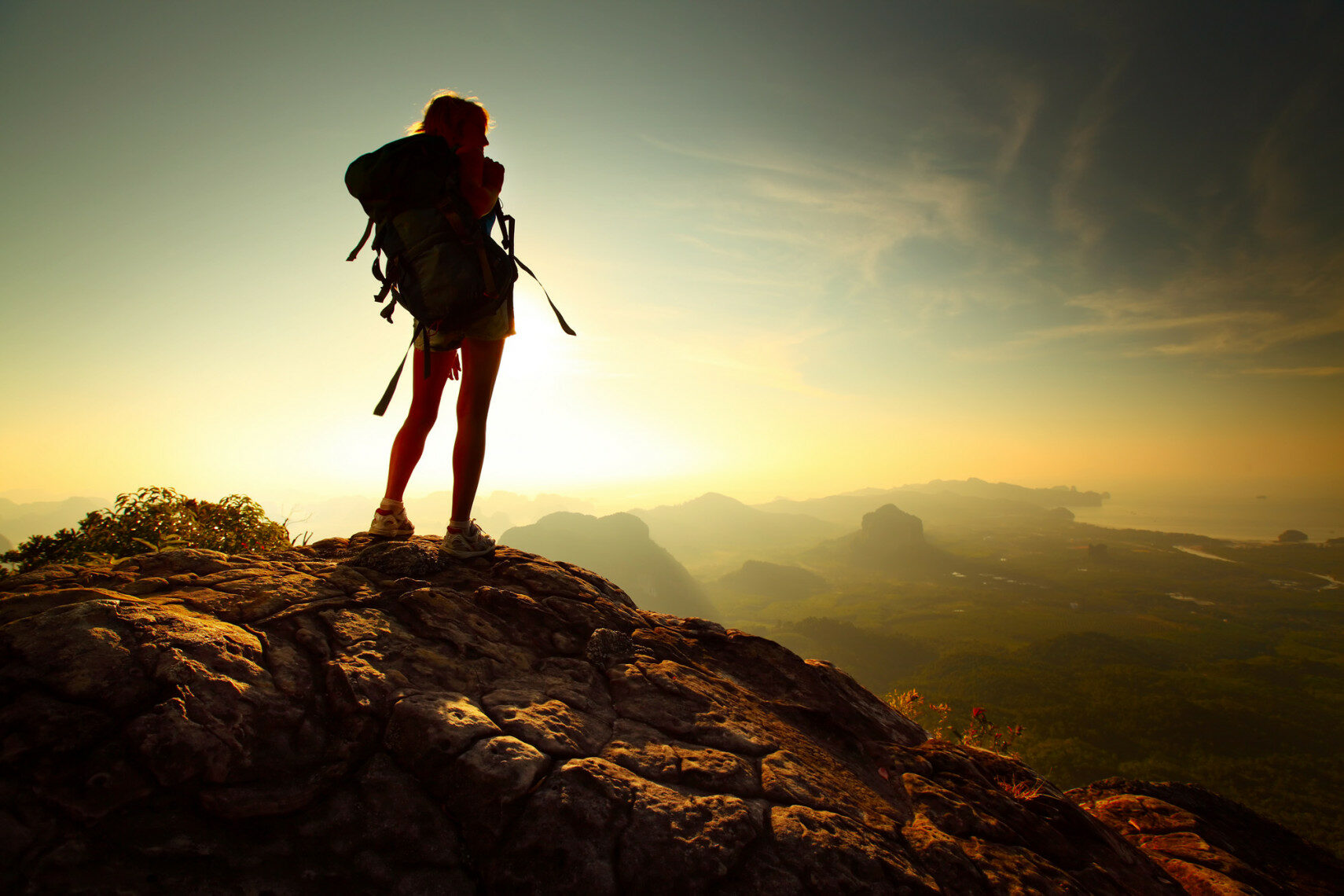Often in stressful times or when repairing our health, it’s in our best interest to halt training for sport to mitigate any added stress and make healing and wellness the priority. It’s hard to fix health when you’re still training aggressively—either the training becomes sub-par (leading to more frustration and stress) or health issues suffer, get worse or never get better. So ease up on yourself and prioritize! If health is in need of serious repair, and you know this deep down, then let the training and racing go for a while. I promise, it will still be there when you’re healthy again and ready to get back at it.
Or, maybe your health isn’t suffering per se, but life is just throwing curveballs left and right and you’re going through tough times in your personal life, with family, at work, at school, etc.—consider this all added stress. Usually, not the best time to hit it with hard training too. You don’t have to just “suck it up” and try to be tough and stubborn—it’s ok to go easy on yourself and find ways to decrease the stress burden; I give you permission.
That said, when you commit to halting your training, this doesn’t mean you have to retire to the couch and become a lazy inactive bum, which would probably be the worst thing you could do if you love outdoor activity and a good sweat. While there is an argument to be made for more relaxation and couch time for some of us hard-hitters (I’m raising my hand), we also know undoubtedly that exercise and movement releases feel-good brain chemicals such as endorphins. But forcing exercise just to feel better is a problem and often leads to excessive exercise at the cost of wellbeing. For example, I don’t like when I hear people using their training as an escape from their life and problems, ignoring issues that need addressing.
So, this list shares some ideas on healthy activities that can work wonderfully in a healing protocol or simply when you need some downtime to destress.
These very things worked for me when I was healing my gut and autoimmune condition. In fact, while I was in the process of healing these issues, I was still logging 10 hours of weekly activity! But it surely was not the typical training that comes to mind. Instead, it was good for the #mindbodysoul.
Log your stress-free healing activities, and log the things you do even if your heart rate never reaches over 100 bpm! Log your sauna time even if you’re sitting there sedentary. These things make a difference that’s worth tracking. It’s all about perspective. See screenshots from my Training Peaks account during my low-stress healing phase for some inspiration.


1. Walking
- So much walking! Embrace walking; it’s brilliant for all humans no matter what pace you’re used to going on two feet. I used to think walking was silly and a waste of time (for years) but this all changes in 2015. I now walk daily to some extent, and I love it. After the Boston Marathon and in recovery mode, I was walking 15-25 miles a week. To spice up your walks:
- Listen to podcasts—continue your education on whatever topic you desire.
- Meditation walks—for the ultimate peaceful activity, download a guided meditation or the meditation radio station on iTunes and absorb yourself in the present. Experience and feel the surge or power this provides the mind, body and soul!
- Enjoy music—there’s nothing better to lift your mood than some of your favorite songs. If I need a lift, I like to listen to our wedding playlist. If I’m feeling nostalgic, I listen to my favorite songs from my youth. If I need a mini “escape” I turn on reggae, Hawaiian music or island-style tunes. If I’m feeling happy and excited, I turn on something to which I can sing along.
- Embrace the silence and nothingness—sometimes we just need to embrace the quiet. You can put in your earbuds or noise-canceling headphones with nothing playing, no sounds.
- Embrace your surroundings—view the world, stop and smell the flowers, don’t rush, smile at passersby, talk to a stranger, walk with a friend or partner. My husband and I have had some of our most deep and memorable chats while walking or hiking.
2. Infrared Sauna
- Every positive thing you read and hear about infrared sauna is true. This is probably the No. 1 way to decrease one’s “body burden,” toxic buildup and promote massive detox. Usually sweating during exercise can have the same or similar effect, but if you’re “off” that kind of training then the sauna is the next best thing to still get your sweat on without asking too much of the body.
3. Low-Intensity Strength Work
- Not circuit training, not crossfit. Rather, practice mindful movements and appreciate the strength you have. Pullups (assisted as needed—I use a band), Turkish Getups, deadlifts, farmer carries, and primal-like movements. Instead of a hardcore workout all within 15 min, spread out your strength efforts, be barefoot, take your time to do the movements well, and take the practice outside if you can!
4. “Running”
- Not all running is created equal and this is not the same type of running you do whilst training. This is free flowing with zero performance expectations or mental hang-ups about how you’re doing. This is more like: Go out and start with walking. Once warm do some jog/run intervals at a 10:00-18:00 min/mile pace, no agenda, no mileage goals, just 2-3 miles, with lots of walking mixed in.
- You can’t wear a heart-rate monitor or “worry” about pace. Ok, so you can wear your GPS Watch or Activity Tracker so you can log the data as I suggested. But still, sometimes it’s best to just carry your phone and check the Heath Dashboard later for mileage, or nothing at all and just run free.
- That said, every so often if you get a bug up your butt to do some “intervals” (like I did)—fartlek style or a half to full mile at a faster pace—then just go for it. You have to know your limits, though, and not cheat this as a way to add intensity when you don’t need it. When you do feel good to add these, there is absolutely nothing forced about it, and you do it very infrequently (no more than 1x a week).
5. Bikram Yoga
- If you’re not great at meditation, yoga may be your answer. Personally, I love and recommend bikram to athletes—it’s the same 26 poses every class and you’re constantly learning more about your body, its mobility and stability. Bikram is also done in a hot room and the sweat factor makes it a great detox as well.
6. Weighted Vest Walks or Hikes
- There’s something about adding a load to your body and moving up mountains. On those days when you feel good, try this instead of a run and if possible hike a hilly trail. The weighted vest poses a whole new dynamic and challenge, taking walking to the next level. It’s weight-bearing, adding a load to the spine and hips to strengthen our bones—so also be sure to practice perfect posture when walking with your vest to avoid aches and pains! For females, I recommend 10-20lbs, for 30-90 minutes. Men can usually add more weight. But don’t add too much weight at the price of quality movement!
7. Stand-Up Paddling (SUP)
- To me, SUP is a peaceful, spiritual experience. It’s also about as mindful as an activity can get—OK maybe archery is more so, but I live by the beach so SUP makes sense. SUP is a way to connect with every muscle in the body in a dynamic environment. While this activity can be intense and a hell of a workout (I’ve raced an open SUP event and it crushed me!), the majority of the time I SUP to relax, disconnect from “real life,” and soak up the ocean vibes. It’s something that can be mellow but underneath it’s incredibly effective for our body’s wellbeing, just like yoga is, but with SUP you’re plopped out in Mother Nature and anything can pop up to keep you on your toes—or rather, keep your feet “screwed in” to your board 😉
8. Ocean soaks (or lake, open body of water, ‘salt-water’ pool)
- Athletes, can we just let go of the idea that every outdoor activity needs to be a physical workout?! There is plenty of benefit to simply jumping in a body of water, letting go of tension, and floating. It’s actually a good test—if you’re overly tense and “fighting” the water (or an underlying issue) your body will want to sink. You don’t want to sink, so find a way to be a floater. There’s also a parasympathetic response to being submerged in mildly cold water that’s tolerable (not freezing water). Bottom line: water therapy is real, and it’s free. I often do an ocean soak session after a SUP, a great cooldown, for just 5-10 minutes.
- I’ve had clients who are terrified of open water—whether lake or ocean—and so there’s an added bonus of overcoming fear if you fall in this category. Life is about going outside your comfort zone.
9. Ocean (or open water) “swims”
- This is not a race, this is not a swim meet. When I give athletes recovery swims I like to call them “flops”—open water swims can be just that. This is a chance for you to channel your inner kid and frolic around with goggles (and fins if you like) for just 10-20 minutes. You don’t have to even be an accomplished swimmer; in fact you’re allowed to suck! Just use basic skills to move from point A to point B and back. This is truly the easiest swimming you can imagine—so get comfortable with it even if your Type A competitive mind wants to take it up a notch and hammer. Life is not always a race or about “who’s the fastest.”
10. Nature Hikes or Backpacking…
- …aka “forest bathing.” There’s nothing more healing and invigorating than going off the grid and into Mother Nature. In fact, research shows that “forest bathing” boosts our physical and mental health in a myriad of ways including decreasing feelings of depression and anxiety, lowering stress and allowing for the cultivation of new self-love and personal growth. Out in nature and away from artificial light, we also reset the circadian rhythm and can get some of the best sleep of our lives. So it doesn’t just have to be a day-hike—make it a multi-day adventure. I find that it takes three days to really get the true essence of being in the great outdoors and forget about modern living. Plus, there’s simplicity to being in nature, especially with backpacking, when all you need is on your back and nothing else matters.
- Research shows that forest bathing may even protect us against cancer by boosting our immune function.
11. Camping
- If you’re not quite ready for the rather-grueling demands of backpacking (including all the necessary gear and prep before you take a trip) that’s fine, try some car camping instead! It can be much less daunting and easier to just load up the car and take off to find a little piece of land to make home for a few days. Try to keep your packing as minimal as possible, i.e. no video games, laptops, or electronic devices outside a phone or safety items. The best thing about camping and backpacking is that your destination fees are usually dirt cheap (no pun intended)!
12. The Unknown
- Try something completely new! For me this happened to be SCUBA diving, which I do with my husband. SCUBA offers everything I love in an activity: it’s a challenge (and a thrill), mentally demanding, gets you outside your comfort zone, keeps you sharp, and requires physical awareness and control. It’s not necessarily physically taxing and in fact you want to be as Zen as possible to conserve energy and not hold high heart rates. However, the gear is heavy, and if you have to walk to and from your dive spot (i.e. shore entry) this can quickly become a gnarly little workout. But even if you’re diving off the boat, I think it’s still physical in the sense that you need good coordination, motor control, body awareness and mental fortitude—everything we need to better ourselves. So maybe it’s not SCUBA for you, but look for the same criteria in your “unknown” activity of choice.
Comment below and further the discussion on non-training activities YOU do and enjoy, and why.
References
http://www.ncbi.nlm.nih.gov/pmc/articles/PMC2793341/

